No. 18, Vol. 2. Vernal Equinox 2010
(Note: This article is a chapter from the forthcoming The Ophanic Revelation, available in English from Aethyrea Books and Italian from NewLife Ediziona in May.)
The Ophanic Alphabet (Part Two): A Search For Meaning
by DARLENE
In Part One, we analyzed four key versions of the Ophanic alphabet and discovered the significant impact that seemingly small changes can have upon alphabetic forms.
When one is finally prepared to understand the nature of the Ophanic system, it will be tremendously valuable to work with the Ophanic letters within context. “Understanding Ophanic” means to completely immerse oneself within the letters. Fourteen years ago, in 1995, through the very process of creating the elemental tablets and all the other furniture associated with the Enochian system, I received many crucial insights.
Especially worthy of mention is what unfolded during the process of embroidering the Ophanic letters onto red cloth for the Holy Table. Using golden thread, I worked intimately with my fingers. To ensure I placed my needle accurately, I was forced to slow my pace. While it takes only seconds to reproduce a symbol with a writing implement, it takes many untold hours of intense focus to duplicate the form using needle and thread. So the process of sewing letters by hand was very tedious.
As I became accustomed to a much slower, more methodical cadence, something amazing happened. Time and timing became crucial. As my work progressed, I became aware that I instinctively sewed with natural regularity at a measured pace which began to syncopate with the rhythmical pattern of larger cycles, expanding my awareness and connecting me with what I can only describe as Universal Mind. Working intimately with symbolic forms in this way also tapped me directly into my right brain processes. As a result, I developed a more powerful sensitivity to spatial relationships and my perspective broadened.
If the very process of working with the Ophanic letters increases one’s sensitivity to tempo, time and space, there has to a reason. To uncover the deeper meaning inherent within the Ophanic letterforms is to fathom the larger patterns at work. The purpose of Part Two of this article is to uncover and discover what kind of patterns can be discerned and what kind of meaning can be inferred from those patterns.
Deriving Meaning through Classical Geometry
Because geometric structures create our world, we can say the foundation of geometry is the universal expression of shape. Different geometric shapes give rise to unique patterns of vibration and resonances within the greater whole. Sacred geometry is a mathematically precise dynamic that organizes matter to take coherent form in space. The study of sacred geometry teaches us to appreciate proportional relationships and allows us to recognize the spatial dynamic of the parts to the whole (refer to Section Four of The Ophanic Revelation book: Basic Ophanic Geometry).
If we divide every letter into their constituent parts and examine each part’s seed forms from John Dee’s perspective, what secrets will be revealed? Applying classical geometric canons that were familiar to Dee to interpret the meaning of each separate shape may prove to be quite edifying.
As in geometry, we begin with one of the simplest geometric concepts: the point. With no length or width, a point specifies an exact location within a given space. Consisting of neither volume, area, length, nor any other higher dimensional analogue, a point is a 0-dimensional object, symbolized by a small dot. The dot represents the beginning, the origin point, the center from which everything is measured. A dot comprises part of the Enochian letters X and Y.
![]() A straight line connects two points via the shortest path, extending forever in both directions. However, a line segment comprises only the part of a line between two points. The Ophanic characters that employ the use of a long horizontal straight line are: C, E, I, Y and Q. Symbolically, a horizontal line implies the horizon which is associated with open possibilities, fresh opportunities and new beginnings.
A straight line connects two points via the shortest path, extending forever in both directions. However, a line segment comprises only the part of a line between two points. The Ophanic characters that employ the use of a long horizontal straight line are: C, E, I, Y and Q. Symbolically, a horizontal line implies the horizon which is associated with open possibilities, fresh opportunities and new beginnings.
![]() A straight vertical line carries with it the connotation of ascension and strength. Moving upward towards heaven, Enochian letters with vertical stems are: E, I, Q, Y and Z. Like a tree, a column, or human spine reaching in both directions down to the ground and up to the sky, a vertical line symbolizes life and growth. Within his tome, Monas Hieroglyphica, John Dee wrote (Theorem II):
A straight vertical line carries with it the connotation of ascension and strength. Moving upward towards heaven, Enochian letters with vertical stems are: E, I, Q, Y and Z. Like a tree, a column, or human spine reaching in both directions down to the ground and up to the sky, a vertical line symbolizes life and growth. Within his tome, Monas Hieroglyphica, John Dee wrote (Theorem II):
The circle without a straight line cannot be artificially created, nor a straight line without a point. Consequently, everything, properly, began from the point and the monad. And whatever is strived for by the periphery of the circle, no matter how big it is, can in no way succeed without the ministry of the central point.[1]
![]() Our “line” category also includes the Enochian letters with straight components oriented upon a diagonal, like A, B, F, parts of L and D.
Our “line” category also includes the Enochian letters with straight components oriented upon a diagonal, like A, B, F, parts of L and D.
Through association, these letters anticipate the first geometric figure: the triangle.
 Straight Enochian letters like E, Q and Y that have both horizontal and vertical elements which connect at right angles also have three points: the beginning point, the ending point and the point of intersection in the middle. Even though the third side would be invisible, the form suggests the geometric figure of a right triangle. Three points also suggest the three-dimensional concept of a plane in space. Inherent within the triangle is the numerical symbolism of three, the nature of which expresses itself in the concept of the triad, or trinity-past/present/future; man/woman/child; thesis/synthesis/antithesis; virgin/mother/crone, mind/ body/ spirit; etc… and can be understood as a key to creativity, versatility and expression.
Straight Enochian letters like E, Q and Y that have both horizontal and vertical elements which connect at right angles also have three points: the beginning point, the ending point and the point of intersection in the middle. Even though the third side would be invisible, the form suggests the geometric figure of a right triangle. Three points also suggest the three-dimensional concept of a plane in space. Inherent within the triangle is the numerical symbolism of three, the nature of which expresses itself in the concept of the triad, or trinity-past/present/future; man/woman/child; thesis/synthesis/antithesis; virgin/mother/crone, mind/ body/ spirit; etc… and can be understood as a key to creativity, versatility and expression.
 When two lines intersect at an angle of 90° and share a common point, the figure of a cross is created. The cross connotes balance--the connection between heaven and earth, male and female, positive and negative and other polar opposites. According to Dee, the “Cross is the hieroglyphic sign of perfection.” A and N are the two Enochian letters which include elements composing an equilateral cross. In Theorem XVI within his Monas Hieroglyphica, Dee wrote:
When two lines intersect at an angle of 90° and share a common point, the figure of a cross is created. The cross connotes balance--the connection between heaven and earth, male and female, positive and negative and other polar opposites. According to Dee, the “Cross is the hieroglyphic sign of perfection.” A and N are the two Enochian letters which include elements composing an equilateral cross. In Theorem XVI within his Monas Hieroglyphica, Dee wrote:

At this point in the discussion of our proposition we must philosophize a little concerning the CROSS. Although our CROSS is composed of two straight lines (as we said), and the lines are of equal length, they do not divide each other into equal lengths. But in the mystical arrangement of our cross we wanted to have both equal and unequal parts, to affirm that in the power of two lines divided in this manner is hidden also (because they are equal in size) the virtue of an equilateral CROSS. For, a certain JUSTICE of NATURE very generally requires that a CROSS is to be drawn with equal straight lines, and in the dividing of the lines cross-ways [that is, in the form of an ‘X’] its lines ought to be equal to begin with.
As described above, Dee dissected the cross into two units. The letters conforming to the way Dee divided the cross is the Latin “L” and the Enochian E, both equal and opposite.
Traditionally, the cross is a 4-sided orientation in space and represents the four basic forces of spin in the universe. We may also call the active forces which move outward, “yang,” and the receptive force drawing inwards, “yin.” Feminine energy is both receptive and active, the latter within the former. Masculine energy is both active and receptive. When the cross is placed within a circle, it becomes the traditional symbol for earth.
Following are Dee’s comments regarding the cross and the four elements (Theorem VII):
The elements that are removed from their natural seats and whose homogeneous parts are scattered, will teach experimenters that the elements naturally return to their places by means of straight lines. Thus it will not be absurd [to say] that the secret of the FOUR ELEMENTS (into which all elementary things can in the end be dissolved) is affirmed by means of 4 straight lines that expand from a single and indivisible point into 4 opposite directions. Here you will carefully note what the Geometers teach: a LINE is produced from the FLOWING OF A POINT. And using this same principle, we point out that this is also the case in our mechanical magic, because the lines indicating our elements are produced by the continuous fall of DROPS (which are like physical points) [moving] as though they are FLOWING.”
![]() The circle is an ancient and universal symbol for oneness, wholeness, unity, completion and sacred space. The strokes and counter spaces of many Enochian letters—B, G, D, H, L, M, N, P, R, Z—are circular in nature. Dee relates the nature of the circle to that of the sun and writes about the line and the circle in Theorem I:
The circle is an ancient and universal symbol for oneness, wholeness, unity, completion and sacred space. The strokes and counter spaces of many Enochian letters—B, G, D, H, L, M, N, P, R, Z—are circular in nature. Dee relates the nature of the circle to that of the sun and writes about the line and the circle in Theorem I:
By means of the straight line and the circle, the first and simplest production and representation of things was made in the light, as were non-existent things and those that are hidden behind the veil of Nature.
![]() In Theorem IV, Dee relates the semi-circle to the moon:
In Theorem IV, Dee relates the semi-circle to the moon:
Although the semi-circle of the moon is above the Sun, as it were, and comes first, nevertheless the Moon regards the SUN as lord and king; the Moon even seems to rejoice over the sun’s form and vicinity, since the Moon, in one way, emulates the size of the Sun’s radius (or so it appears to the ordinary person) and in another way the moon constantly turns its light toward the Sun. And finally, the Moon so desires to be filled by the SUN’S rays, that it, so to speak, transforms into the Sun and disappears completely from the sky, until it appears again after a few days in the form of a little horn, exactly as we have depicted it.
![]() Lastly, there are curved elements that can best be described as Arcs. An arc is a portion of the circumference of a circle. Those Enochian letters composed primarily of arcs are O, T, S but arcs also appear in B, C, D, F, M, N, R and U.
Lastly, there are curved elements that can best be described as Arcs. An arc is a portion of the circumference of a circle. Those Enochian letters composed primarily of arcs are O, T, S but arcs also appear in B, C, D, F, M, N, R and U.
![]() The arc represents an unfolding of that which is hidden or the promise of something greater. For instance, a rainbow is a colored arc. As symbols, arcs have traditionally been classified as either ascending or descending. The descending arc (downward or shadowy arc) represents an involution of spirit whereas the ascending arc (upward or luminous arc) represents an evolution of spirit. Spirit and matter are fundamentally of one essence only they are at different developmental stages. For our purposes here, the arc represents being in a state of development.
The arc represents an unfolding of that which is hidden or the promise of something greater. For instance, a rainbow is a colored arc. As symbols, arcs have traditionally been classified as either ascending or descending. The descending arc (downward or shadowy arc) represents an involution of spirit whereas the ascending arc (upward or luminous arc) represents an evolution of spirit. Spirit and matter are fundamentally of one essence only they are at different developmental stages. For our purposes here, the arc represents being in a state of development.
![]() Arcs could also be considered as parts of the spiral, our final geometric figure. Among the many Ophanic letters that have spiral-shaped components are G, H, M, and R. Spirals are associated with the cycles of time and nature. The spiral shows up in the pattern of seeds in a sunflower, in the growing tips of ferns, in the pattern that leaves grow on a stem, in the shape of a nautilus shell, and, as a helix, the shape of the DNA molecule. As a symbol, the spiral represents a spiritual journey, the evolutionary process of growing and learning.
Arcs could also be considered as parts of the spiral, our final geometric figure. Among the many Ophanic letters that have spiral-shaped components are G, H, M, and R. Spirals are associated with the cycles of time and nature. The spiral shows up in the pattern of seeds in a sunflower, in the growing tips of ferns, in the pattern that leaves grow on a stem, in the shape of a nautilus shell, and, as a helix, the shape of the DNA molecule. As a symbol, the spiral represents a spiritual journey, the evolutionary process of growing and learning.
What other stories may be hidden within the component parts of the rest of the alphabet?
Moving Beyond the Point, Line and Cross
In our journey of discovery, comparing the Ophanic letters against classic geometric canons moved us a good distance from our starting point. But there are other ways to cultivate meaning besides chopping up the Ophanic letters. If we regard the letters as a collective of interrelated units, it’s possible to uncover the hidden geometric relationships between number, proportion, and pattern.
The angel Raphael introduced the Ophanic alphabet in a very specific, peculiar, but important order. In Quinti Libri Mysteriorum Dee reports that after dictating the letters by name, that “there cam two lines and parted the 21 letters into 3 partes, eche being of 7.” In other words, moving right to left, the angel divided the letters into 3 rows containing 7 letters each. Raphael then pronounces: “The Number, O most perfect, One and Threefold, Glory be to you.”[2]
The importance of this particular sequence has been the subject of much speculation. However, easy answers have never been forthcoming, even up to the present time. In 2007, a Nottingham University English scholar, Martin Findell, decided to try his hand at deciphering the mystery and noted the following:
The division of the alphabet into three produces another noteworthy feature which might be the result of deliberate organization. Within each group of 7 letters there is one which occupies the same ordinal position in both the Roman and angelic alphabets. These are D (group 1, position 4), I (group 2, position 2), and U (group 3, position 5). These three letters together spell the Latin word diu “by day; for a long time”. If the pattern is intentional, diu could perhaps be a reference to the coming of the day of redemption after long ages of mankind’s suffering; though this connection is tenuous at best. A more promising alternative would be to construe the “stationary” letters as D and the Roman numeral IV - D being the fourth letter not only of the Roman and angelic alphabets, but also of the Greek and Hebrew; and, of course, Roman D is homophonous with the philosopher’s name.[3]
But after pursuing several areas of inquiry, Findell ultimately gives up:
Entertaining as it is to speculate that these letters (DIU) form a key to the ordering of the alphabet, I have had no success in identifying any way to use this hypothetical key to link the 7-letter groups either to one another or to their corresponding groups in the Roman alphabet. If the patterns identified here are genuinely involved in the construction of the angelic alphabet (and I doubt that this is the case), I am forced to admit defeat, at least for the time being, in my efforts to determine the method used.[4]
The author then concludes that the alphabet, having emerged from Kelley’s subconscious, would bear striking similarities to other known alphabets without possessing any coherent structure of its own and that there is no meaning to be deciphered. My own conclusion is simply that the pattern has yet to be discovered.
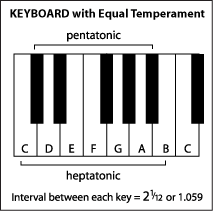 The Magic Seven
The Magic Seven
Whatever the Ophanic pattern may be, it prominently involves the number seven. Associated with the number seven are many interesting things: the 7 days in a week, the 7 planets in astrology, the 7 metals of alchemy said to be governed by 7 angelic intelligences; not to mention, of course, the 7 deadly sins. So I’ve become extremely sensitive to sevens.
Synchronously, during the writing of this article, I encountered an image (redrawn left) which gave me pause. I had seen images of piano keys before, only this time I recognized the numbers 5, 7, and 12 as very meaningful. Suddenly, the idea occurred to me that our three groups of seven letters could simply be indicating the levels of three octaves. Since I know next to nothing about musical notation, I had to quickly familiarize myself with the basics.
The best explanation I found of how the number 7 relates to an octave (8) in music came from Douglas Hofstadter’s Metamagical Themas:
On a piano there are twelve notes (some black, some white) from any note to the corresponding note one octave away. Playing them all in order creates a chromatic scale, as contracted with the more familiar diatonic scales (usually major or minor). These latter involve only seven notes apiece (the 8th note being the octave itself). The seven intervals between the successive notes of a diatonic scale are not all equal. Some are twice as large as others, yet to the ear there is a perfect intuitive logic to it. Rather paradoxically, in fact, most people can sing a major scale without any trouble, uneven intervals notwithstanding, but few can sing a chromatic scale accurately, even though it “ought” to be much more straightforward-or so it would seem, since all its intervals are exactly the same size. The chromatic scale is so called because the extra notes it introduces to fill-up the gaps in a diatonic scale have a special kind of “bite” or sharpness to them that adds color or piquancy to a piece. For that reason, a piece filled with notes other than the seven notes belonging to the key it is in is said to be chromatic.[5]
An octave comprises seven fundamental notes: do-re-mi-fa-sol-la-ti. The eighth note, do, is a repeat of the first but with the pitch frequency doubled. It is also the first note of the second octave. Accordingly, the eighth note of the second octave–again, do –is the first note of the third. Comparing the musical notes on the diatonic scale, to the letter arrangements, each row of letters represents one octave. The letters in each column and row bear a unique relationship to one another in terms of their mathematical properties.
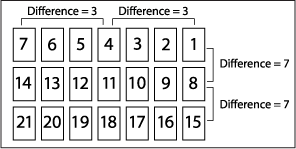 Some appealing arithmetic principles correlate with the particular geometric arrangement of three septenaries. William S. Burkle refers to this arrangement as the “3 X 7 tableaux” and illustrates a number of interesting mathematical phenomena [6]. For instance, when the numeric of any two vertically adjacent numbers in any given row are subtracted, the difference equals seven. When the values of first and last numbers in each row are subtracted from the central number in that same row, the difference is always three. Furthermore, the numbers in the center row will have a value equal to the mean of the two numbers immediately above and below. There are many more examples of this strange interactive influence between the geometric arrangement of the numbers and simple arithmetic. If John Dee knew about the mathematical properties of the 3 x 7 tableaux, he would have appreciated their simple elegance.
Some appealing arithmetic principles correlate with the particular geometric arrangement of three septenaries. William S. Burkle refers to this arrangement as the “3 X 7 tableaux” and illustrates a number of interesting mathematical phenomena [6]. For instance, when the numeric of any two vertically adjacent numbers in any given row are subtracted, the difference equals seven. When the values of first and last numbers in each row are subtracted from the central number in that same row, the difference is always three. Furthermore, the numbers in the center row will have a value equal to the mean of the two numbers immediately above and below. There are many more examples of this strange interactive influence between the geometric arrangement of the numbers and simple arithmetic. If John Dee knew about the mathematical properties of the 3 x 7 tableaux, he would have appreciated their simple elegance.
What is pertinent to our discussion is that Burkle also reveals the little-known correspondences of the 3 x 7 tableaux to musical notes. Apparently, Paul Foster Case as well as some members of the Golden Dawn figured out the relationship of the Tarot trumps to music. Since only the pattern is my primary interest, I freely adopt this model as a starting point. But before we proceed, let’s first consider the 3/7/12 system of modal music as it pertained to music in the 15th century:
;We complete our assessment ... by investigating the other worldwide esoteric system available to the Renaissance Magi that was operated via a 3/7/12 model. I am referring here to the 3/7/12 system of modal music, which the Renaissance magi took great interest in for healing purposes. To be brief, the “three” (as in Mother Letters) are the three genera of the Greek musical Modes, the chromatic, the enharmonic, and the diatonic. The “seven” is the seven notes that make up any scale, octave to octave. The twelve is the number of intervals of division available within the octave, from which a scale is selected. Twelve is the number of mathematical zones or slices into which the octave is divided, seven of which will be picked to make up the notes in the scale. So twelve represents the number of mathematical decisions that have to be made to define an octave, any octave, out of the infinite glissando of rising and falling notes available in nature.[7]
This 3/7/12 idea turns out to be common between the Hebrew, the Greek, and the Hindu canons of music.[8] The model of tonal correspondences I borrowed to correlate the Ophanic letters with musical tones originated from Alan Bennett (1872-1923). Initiated in 1894, Alan Bennett was a member of the Hermetic Order of the Golden Dawn and also a friend, mentor and associate of Aleister Crowley. Robert Wang (creator of the Golden Dawn Tarot Deck and the Jungian Tarot Deck), one-time secretary to Israel Regardie, said he’d gleaned the information himself from one of Bennett’s notebooks.[9]
Music is vibrational physics sensed through the ear/brain combination and has existed in written form as far back as ancient Sumeria. The old frequency for middle C seems to have been about 256 hertz, a doubling of 128, which is 64 doubled, which is 32 and so on. Physics describes “Harmonics” as proportional frequencies at inversely proportional amplitudes. If we play an “A” (440hz), harmonically we will not only hear the 440hz tone, but also an overtone of 880hz at half the volume (first harmonic), a 1320hz tone at a third the volume (second harmonic), a 1760hz tone at a quarter of the volume (third harmonic), etc., until the frequencies get too high or the volume gets too low to be detected by the ear. The musical scale is a natural consequence of pure mathematics and nature. It was not invented, but discovered--one good reason why music can be regarded as the true universal language and why it is appropriate to our discussion here.
All objects have a frequency or set of frequencies with which they naturally resonate. When an object is forced into resonance, whether struck, plucked, strummed or otherwise disturbed, it vibrates at one of its natural frequencies in such a manner that a standing wave is formed within the object. The standing wave pattern represents the harmonic frequencies established within that object. Everything to know about a quantum system can be discovered through the calculation and analysis of its wave function. The model of Quantum mechanics is merely another way of to describe the harmonic structure of space. What if each Ophanic letter can be associated with one or more standing waves?
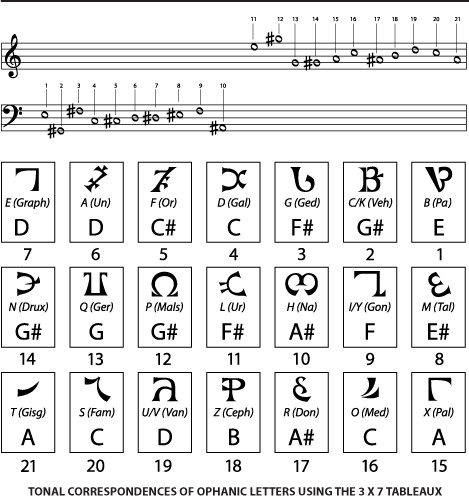
Standing Waves form Platonic Solids
The students of Buckminster Fuller (b. 1895 - d. 1983) and his protegè Dr. Hans Jenny (b. 1904 - d. 1972) dipped a spherical balloon in dye and pulsed it with pure sine wave sound frequencies. As a result, a small number of evenly-distanced nodes connected by thin lines formed across the surface of the sphere. In 3D, these standing waves produced structures corresponding to the platonic solids. A tetrahedron is formed from four evenly spaced nodes. Six evenly spaced nodes form an octahedron while eight evenly spaced nodes form a cube. Twelve evenly spaced nodes form the icosahedron and twenty evenly spaced nodes form the dodecahedron.
This experiment confirmed that within the atom (the basic building block of matter) the platonic solids are formed in a vacuum by electromagnetic waves. Dr. Jenny’s work marked the beginning of the new science of modal phenomena or “Cymatics,” the study of visible sound and the patterns made by certain sound frequencies as they vibrate from the surface of a plate, diaphragm, or membrane. People interested in viewing the original results of this seminal study are encouraged to read Jenny’s 1967 ground-breaking book, CYMATICS, A Study of Wave Phenomena.[10]Light is a wave form, a frequency which operates in the same spectrum as sound, but only at a much higher vibrational rate. The DNA of all living things emits photons (Refer to the entire Section 3 of this book). All living plants and animals possess a faint bio-luminescent glow in the small and compartmentalized spectrum of visible light from infrared to ultraviolet. Scientists, such as Mitsuo Hiramatsu of the Central Research Laboratory at Hamamatsu Photonics in Japan, theorize the light “is a kind of chemiluminescence,” a luminescence based on chemical reactions, such as that which make fireflies glow.[11]
In 1988, Dr. David Deamer collaborated on a project to measure the vibrational frequencies of the four DNA base molecules to translate them into sound. Deciphering DNA frequencies into sound led to unusual insights into the harmonic fabric of DNA. In her abstract, “The Infrared Frequencies of DNA Bases as Science and Art,” Susan Alexjander wrote:
The questions of ‘translating’ light into sound is more a philosophical one. Sound sped up can of course never be light, since the former depends upon molecules to push around while the second derives from electromagnetic radiation. One could argue that what is important here is not so much the medium but the ratios involved; the relationships between frequencies. The ears can detect about 10 octaves of sound, while the eyes can only perceive a little over one octave of light, or color. An octave in light is the same ratio as an octave in sound... 2:1. A perfect fifth, or a relationship of 3:2 is the same proportion in light as sound (and can be continued into the world of geometry, architecture, movements of the planets and so forth; anywhere there is a periodic or regular vibration). By discovering patterns of ratios in light, we are simply translating into a sound medium to “hear” what information they might contain and how they relate to each other. It could also be argued that both light and sound refer back to a common archetype which, as yet, is unknown to us, not unlike cousins who relate back to a common relative.
Again, four base molecules were measured: adenine, cytosine, guanine and thymine. Each base molecule after being subjected to light yielded about 15 or 18 frequencies; 60 in all.[12]
We will return later to the subject of how the Ophanic letters may relate to the above-mentioned sixty sound frequencies detectable within our DNA.
Dimensional Doorways
Thus far, we’ve examined Ophanic against the classic geometric canons and considered the meaning behind their arrangement on a 3 x 7 grid which pointed to a possible relationship with musical scales and octaves. We have assigned tonal equivalents to the letters giving us such interesting concepts as wave-length, vibration, frequency and harmonics to mull over. We’ve discovered that the standing waves produced by sound will create the platonic solids and noted the possibilities of translating light-emitting DNA into sound. Let’s now revisit the Ophanic letters and regard them abstractly--as 3-D objects moving freely in space.
One of the primary features of the Ophanic letterforms is the relationship between the thick and the thin strokes. What is the reason for the thick strokes? The thick/thin ratio could suggest a spatial relationship. If the thick strokes are closest to the viewer, would the thin strokes indicate the parts of a letter that are being stretched the furthest through out space?
My favorite explanation is that the Ophanic letters are merely shadows of different flows of energy. The existence of the 16x16 grid (refer to Section 6: The Complete Ophanic Handbook) with its four different symmetry sets, or vantages of the 8x8 grid suggests that each letter’s proper spatial orientation is a key factor.
 Let us begin with the simplest letter: “T.” In 2-D, the letter is a three-sided shape containing only three points. Essentially, it’s a triangle. The 3-D representation of a triangle is a tetrahedron, but if the surface of the solid is curved, a cone is produced. The cone has a flat round base and its sharp, pointy end is called the vertex or apex. Mathematical equations defining conic structures usually imply the existence of the cone’s reflection through the apex: the double cone. The double cone is familiar to us because it is usually the model that illustrates Einstein’s concept of Space-time. When considering the letter T in 3-D as a conic shape, its Space-time association may end up being an integral aspect of the letter’s dynamic function.
Let us begin with the simplest letter: “T.” In 2-D, the letter is a three-sided shape containing only three points. Essentially, it’s a triangle. The 3-D representation of a triangle is a tetrahedron, but if the surface of the solid is curved, a cone is produced. The cone has a flat round base and its sharp, pointy end is called the vertex or apex. Mathematical equations defining conic structures usually imply the existence of the cone’s reflection through the apex: the double cone. The double cone is familiar to us because it is usually the model that illustrates Einstein’s concept of Space-time. When considering the letter T in 3-D as a conic shape, its Space-time association may end up being an integral aspect of the letter’s dynamic function.
John Dee himself was very familiar with three-dimensional conic structures and referred to them in his treatise, Monas Hieroglyphica written 12 years before he encountered the Ophanic beings. In their discussion of Dee’s Theorem VI in a 2007 article published in The Journal of the Western Mystery Tradition, Burns and Moore elucidate Dee’s mastery of geometry as applied to letterforms:
Dee invites us to visualize the cross in terms of conic sections. First Dee asks us to picture a diagonal passing through a rectilinear cross; basically, a third line running through the point where these two intersect. His references to “V” and light also suggest the shape of a cone, if one imagines this in three dimensions. Then he tells us five (V) is a circular number, alluding to the circle as one of the four conic sections. If one makes the diagonal an axis for two cones sharing the same vertex, or point, and let that point be the intersection of the lines of the cross, we now have two cones and a plane. The plane can intersect the cones in one of seven ways, and makes one of seven figures: a circle, an ellipse, a parabola, a hyperbola, a point, a line, or a cross:
If the plane is running through the vertex, as Dee describes, then we can have only a point, line, or cross.[13]
Wouldn’t it be second-nature for Dee to apply these higher 3-D geometries to the form and structure of the letter shapes presented to him by the angels?
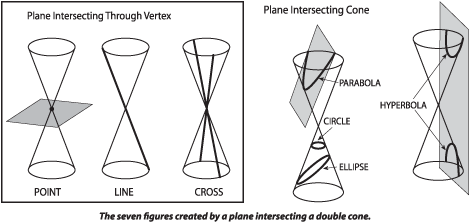
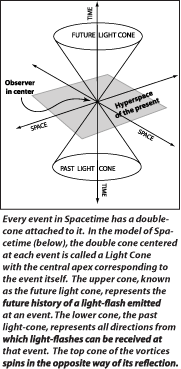 So far, the study of this angelic alphabet has always been from a limited human-centric point of view. Instead, let’s choose to take the long view and see things from the much broader angelic perspective. If we suspend disbelief and become open to the thought that Ophanic is honestly an angelic language, we quickly move out of our depth and comfort zone. It’s useless to debate whether or not Ophanic is “natural” (it is not) and just asking this question completely misses the point.
So far, the study of this angelic alphabet has always been from a limited human-centric point of view. Instead, let’s choose to take the long view and see things from the much broader angelic perspective. If we suspend disbelief and become open to the thought that Ophanic is honestly an angelic language, we quickly move out of our depth and comfort zone. It’s useless to debate whether or not Ophanic is “natural” (it is not) and just asking this question completely misses the point.
Could there be such a thing as a powerful, non-physical, symbolic logos existing simultaneously in all dimensions of time and space? Simply acknowledging the very existence of a vibratory language stretches the definition, as well as the possibilities and ultimate purpose of a sacred language.
What a daunting task it would be for an angelic being to translate 4-D information into a 2-D alphabet simple enough to be understood by human beings existing within the dense gravity-well of physical reality. Ophanic is so unique, it’s in a category by itself and therefore must be examined using criteria beyond 2-D that opens up some fascinating areas of study.
Along with visualizing Ophanic letters as 3-D shapes, what if we broaden our point of view to include movement? Adding the energy of rotation to a cone will produce a form that spins, like a tornado. The T shape, for example, can be perceived as a shadow of one spinning 3-D funnel shape. The letter O is composed of two non-touching spinning vortices. If all the letters are actually dynamically moving forms whirling in space, the only thing we would be able to perceive in 2-D would be their cast shadows. These shapes would change if the shadows of the whirling forms were viewed from different angles. Their specific orientation in space (or position on paper in 2-D) seem to be an important factor.
The reason to introduce the science of how energy flows in an article about letters is because the Ophanic alphabet is an integral part of the geometrical structure that creates a bridge between the “zones” or dimensions. We at least owe it to ourselves to investigate this aspect. The shape of energy is the only thing that could pass through the gap between the physical and non-physical. Waves and frequency also play their part. When examining the letter shapes, it would be well to keep in mind the dynamics of energy’s movement.
 A “spiral” and a “helix” are often confused but represent different objects. A spiral defines a flat, planar curve that emanates from a central fixed point, its curve progressively getting farther away as it revolves around the point, like the grooves on a record disc. Conversely, a helix is a three-dimensional coil that runs along the surface of a cylinder, like the threads on a pipe or a telephone cord. A cross between a spiral and a helix is known as a “Conic Helix.” An example of a conic helix is the tapered spring used in remote controls to hold and make contact with batteries. In nature, the tendrils emerging from the vines of grapes or squash define this shape. A conic helix also happens to be the shape that best describes how energy spins in a vortex.
A “spiral” and a “helix” are often confused but represent different objects. A spiral defines a flat, planar curve that emanates from a central fixed point, its curve progressively getting farther away as it revolves around the point, like the grooves on a record disc. Conversely, a helix is a three-dimensional coil that runs along the surface of a cylinder, like the threads on a pipe or a telephone cord. A cross between a spiral and a helix is known as a “Conic Helix.” An example of a conic helix is the tapered spring used in remote controls to hold and make contact with batteries. In nature, the tendrils emerging from the vines of grapes or squash define this shape. A conic helix also happens to be the shape that best describes how energy spins in a vortex.
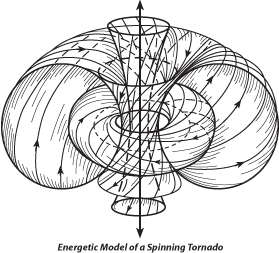 Using the model of a spinning tornado as guide, the general movement of the energy swirls upward towards the wide part of the funnel. Some of the letters seem to possess multiple-vortices, something not unknown to tornados. There are multi-vortex tornadoes that contain two or more small, intense sub-vortices circulating around the center of a larger tornado complex. There are also satellite tornados, weaker tornados that form very near a large, strong tornado but are contained within the same meso-cyclone. Although satellite tornados appear to “orbit” the larger tornado (creating the appearance of one, large multi-vortex tornado), they actually have a distinct funnel, much smaller than the main funnel.[14] The energetic properties of a vortex are phenomenal. As can be seen in the illustration at left, a toroidal shape is created by the way the energy of a vortex moves. It seems as if the Torus is our best 3-D model to understand the primal structure of the universe.
Using the model of a spinning tornado as guide, the general movement of the energy swirls upward towards the wide part of the funnel. Some of the letters seem to possess multiple-vortices, something not unknown to tornados. There are multi-vortex tornadoes that contain two or more small, intense sub-vortices circulating around the center of a larger tornado complex. There are also satellite tornados, weaker tornados that form very near a large, strong tornado but are contained within the same meso-cyclone. Although satellite tornados appear to “orbit” the larger tornado (creating the appearance of one, large multi-vortex tornado), they actually have a distinct funnel, much smaller than the main funnel.[14] The energetic properties of a vortex are phenomenal. As can be seen in the illustration at left, a toroidal shape is created by the way the energy of a vortex moves. It seems as if the Torus is our best 3-D model to understand the primal structure of the universe.
A Torus is a flexible doughnut-shaped vortex of energy that is constantly turning itself inside out. Just like a rotating smoke ring, the Torus is a self-organizing and self-sustaining sphere of energy constantly spinning out from its center. The illustration at the top of the next page shows that a 3-D oscillating vortex ring creates standing waves.

 Likewise, the energy movement of subatomic particles—such as the illustration of an electromagnetic model (above right) of the electron—can also be described as toroidal. These tiny toroidal loops of energy continually unfold outward from their centers and then fold back inward in rapid succession. Although the energy waves of subatomic particles appear to be traveling along a linear path, they are actually concentric waves of larger loops of energy. The electromagnetic model of the electron (above) shows only a portion of its electric and magnetic lines of force but still indicates the energetics of even the smallest of particles are basically toroidal.
Likewise, the energy movement of subatomic particles—such as the illustration of an electromagnetic model (above right) of the electron—can also be described as toroidal. These tiny toroidal loops of energy continually unfold outward from their centers and then fold back inward in rapid succession. Although the energy waves of subatomic particles appear to be traveling along a linear path, they are actually concentric waves of larger loops of energy. The electromagnetic model of the electron (above) shows only a portion of its electric and magnetic lines of force but still indicates the energetics of even the smallest of particles are basically toroidal.
The letter that most resembles a Torus Vortex would be the symmetrical letter H (H). However, the essential structure of the 3-D letter would be revealed only when sliced in half with its bottom partially cored. The letter’s energetics are definitely centrally focused.
As mentioned earlier, one of the most distinctive features of the Ophanic alphabet is its thick, bugle-shaped serifs. Without exception, each letter begins and ends thickly. Thinking in terms of sound, perhaps the fat terminals indicate the some of the different tonal qualities already mentioned. From this point onward, the serifs are referred to as energy portals, or flows. The following study reduces the Ophanic letters into conical projections. The differences between the letters reflect the many ways different cones connect and interact with each other.
The flow mechanics of the Ophanic alphabet involve Helixes, Conic Helixes, and Toroidal Vortices. For the sake of simplicity, each cone’s flow properties are basically described as flowing in one direction, like water spiraling through a pipe. However, it must be understood that the complete energetics are as complex as our model of a spinning tornado. For instance, when tilted properly, the simplest form would represent the probable energetics of the Ophanic letter form T.
Single Vortex curves are secondary strokes which start from a single point somewhere within the main stroke. Vortex Pairs are essentially two cones connected by the main stem. There are several types: pairs which connect gently through a curve, pairs connecting through a straight path and pairs that connect at right angles. The inference is that the energy flow (and resulting sound?) would differ depending upon the letter’s specific structural properties, such as shape and angle. There are also letters containing Conic Helixes that pierce and interpenetrate the main channel, changing the flow properties and, most likely, the tonal qualities.
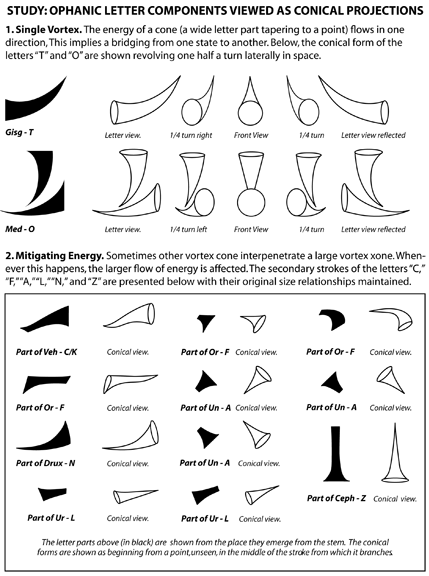
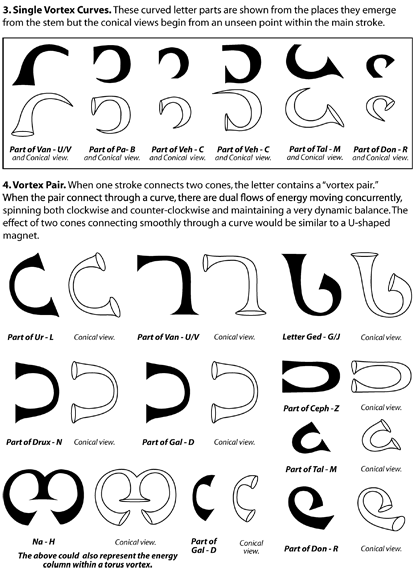
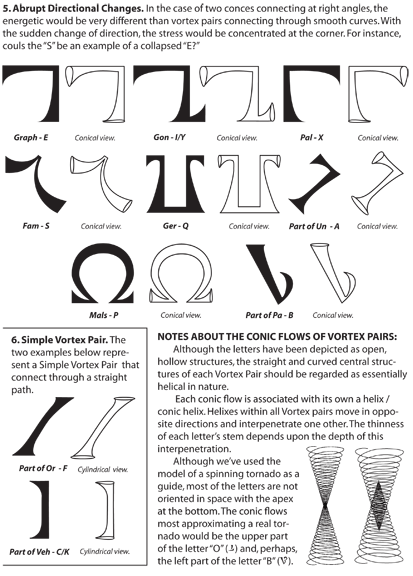
The Wonder and Triumph of “One and Threefold”
Were it not for one important consideration, skeptics might have been tempted to dismiss this entire line of inquiry. But the truth—the undeniable proof of its correctness—can be observed in Raphael’s triumphant words given in Latin after dividing the letters into three groupings of seven. Let us recall what Dee recorded:
Then he lay down before it: and there cam two lines and parted the 21 letters into 3 partes, eche being of 7. He sayd, Numerus o perfectissimus, Unus et Trinus. Gloria tibi, Amen.
The translated Latin reads: “The number, O most perfect, One and Threefold. Glory be to you.[15] In the diagram below, notice that within the first column corresponding to the first line, there are three letters containing five cones, one letter containing four cones and three letters containing 2 cones, totaling seven. . The second and third lines likewise contain the one and three pattern, thus providing us with the following: line one, 3 - 1 - 3; line two, 1 - 3 - 3; and line three, 3 - 3 - 1. Because the pattern could just as easily have involved 2s, 4s or 5s, I contend this “one and threefold” pattern referred to above is Raphael’s way to indicate we are on the right track.

If this is the case, it would only follow that sixty, being the total number of flows, would also be significant. And so it is. Let’s recall another earlier discussion in which “sixty” was found to be the number of frequencies that happen to be detectable within our DNA.
By comparing all 60 pitches, we can find all of the precise ratios found in the first 16 harmonics of the overtone series: octaves, P5th, P4ths, Major and minor thirds, Major and minor 2nds and 7ths; even a ‘flat’ seventh. According to Susan Alexjander: “Mathematically, the odds of this happening at random are almost non-existent."[16] This information is made more phenomenal in consideration of discoveries directly connecting the substance of DNA with the syntax of language.
Language Reflects the Syntax of DNA
In their ground-breaking book, “Vernetzte Intelligenz,” two German scientists cite the work of the Russian biophysicist and molecular biologist Pjotr Garjajev and his colleagues who explored the vibrational behavior of DNA by modulating certain frequency patterns (sound) onto a laser-like ray and discovered it influenced DNA frequency and thus the genetic information itself. Their conclusion: “Living chromosomes function just like a holographic computer using endogenous DNA laser radiation.” The authors, Fosar and Bludorf, go on to say that according to their findings:
...our DNA is not only responsible for the construction of our body but also serves as data storage and communication. The Russian linguists found that the genetic code -especially in the apparent “useless” 90%- follows the same rules as all our human languages.
To this end they compared the rules of syntax (the way in which words are put together to form phrases and sentences), semantics (the study of meaning in language forms) and the basic rules of grammar. They found that the alkalines of our DNA follow a regular grammar and do have set rules just like our languages. Therefore, human languages did not appear coincidentally but are a reflection of our inherent DNA.[17]
If the proper frequencies of sound are used, the DNA substance (in living tissue, not in vitro) will always react to language-modulated laser rays and even to radio waves. Or one can simply use words and sentences of the human language directly since the basic structure of DNA-alkaline pairs and language is of the same structure and no DNA decoding is necessary. They have effectively proven that it is entirely normal and natural for our DNA to react to language.
No one knows how sound, the raw stuff of creation, impacts our being; our consciousness. Mysteriously, we decode meanings which come to us through sonic carrier waves, perceiving these waves as a full-body experience not only through the ears but directly through the bones, tissue and matter of the body. The body mass feels sound as pressure. We know that the body is constantly piezoelectric, translating pressure into electrical signals, such as the way in which the inner ears send signals to the brain. Sound, therefore, impacts the many realms of the molecular world directly and somehow finds its way to the parts of us that make meanings.[18]
Part Two’s search for meaning led us directly to the understanding that a profound relationship exists between the Ophanic alphabet, the geometry of sound/music, and DNA. When investigating how DNA connects with music, Dr. Larry Dossey claims there is no reason in principle why DNA needs to only be described using the terminology of organic chemistry:
It could be described using many symbols, even musical notes. If we were imaginative enough to think musically as well as alphabetically, this just might permit us to hear the music of the body. This experience could provide us with nobler visions of the body, and might allow us at long last to escape the tyranny of machine thinking.[19]
The Whirling Ones
From the latter half of September until the end of 2009, as a part of my quest to comprehend the fuller implications of the Ophanic letters, I submerged myself wholly into the depths of a prolonged creative expedition. Only a few days into the New Year, I return from the holidays with a more detached perspective.
As more objectivity returns to balance out the subjective parts of my experience, I conclude this article. In Part One, I objectively analyzed the physical characteristics of the alphabet. However, in Part Two, I approached the subject matter differently and am aware of having been guided. How many times did I just “happen” to run across the very threads I needed to arrive at a dynamic glimpse of the truth? Throughout the entire creative process, I received many hints in the form of numbers, signs and symbols. All I needed to do was to remain centered enough to notice and follow the guidance of synchronicity. Because Part Two was written at the same time breakthroughs were taking place, it becomes an accurate record of one artist’s creative process.
After reaching the stage of envisioning the letters as conical projections, I began to recall my collective experience of the Ophanic beings that I shared with a handful of other people on an Arizona mountain in 1996. Comparing notes afterward, everyone agreed these Higher Dimensional Intelligences appeared as individual whirling tornados descending from the sky on a luminous corridor best described as “Jacob’s ladder.” Like transparent spinning energy tops covered with thousands of eyes, they spun up and down the brilliance stretching down from the heavens into our circle. They were not scary, but awesome and beautiful and too numerous to count.
Already being familiar with the “Whirling Ones” made me confident I could recognize their energetic signature on a visceral level if I could but reconnect with them intuitively. This informed my decision to approach the meaning of the Ophanic letters with the sensitivities and sensibilities of an artist. If I was less open in my approach, I may not have covered as much ground. Luckily, the creative process allowed me to skip gently along spiral pathways where my attention would be pulled towards certain key nodes or intersection points. In those places, I would linger long enough to obtain momentary but insightful glimpses of the hidden relationships existing between seemingly unrelated concepts.
It was easy to regard the Ophanic alphabet as 3-D energy shapes in constant spin and flux. In meditation, I could “see/feel” parts of the letters dynamically moving in and out of physical reality. The energy seemed to emanate from the thinnest parts and disperse towards the thick parts. With no visible source, I imagined the energy originating and emerging from a different dimension to interpenetrate the fabric of our reality at the thinnest points within the main stem. Then I began to think in terms of sound. Since the inherent geometry of sound is a vibrational frequency which effects our reality, why couldn’t sound act as a catalyst, a conduit that moves information from one phase into another?
We have already glimpsed how our world, the whole fabric of our reality in this dimension, is created by sound. The geometry of sound expresses itself through waves of energy. Energy waves, constant or at least standing in the same place for a little while, builds forms and shapes. Soon I wondered what types of sounds could be produced by each letter. Perhaps the “F” is actually a peculiar type of flute capable of five different tones, the “G” a strange type of clarinet and the “P” a resonant drum. The problem: I only had the vision but did not know the science. My solution entailed locating images resembling what I “saw” within my mind’s eye and allowing synchronicity to help me find them. If this describes lateral thinking, Part Two is ripe with examples.
For the purposes of this article, figuring out all the specifics is not as critical as the general sweep of the information. Whatever the exact correlations may end up being, it’s initially enough for me to understand that probable relationships exist without having to specifically define them. Intimated are interesting affiliations between such diverse things as: sound and vibration as universal building blocks; bonds between harmonics, sacred geometry and symbols; how our DNA resonates with 60 specific frequencies; spinning toroidal structures casting shadows that form an alphabet symbolic of the way DNA responds to syntax; letter sound combinations that promise to trigger the next stage of evolution locked within the human genome, etc… Sound engineers, musicians or those with discerning ears are invited and encouraged to continue the work that unlocks the door to understanding the correlations between the Ophanic letters and their correspondences with the tonal harmonics of DNA.
In closing, the best way I can describe the whole of my experience over the last three months is as a “spiral journey informed by intuition.” The intuitive clues I chased moved me quickly across vast distances, progressing me ever closer and inward to experience minute glimpses of the Truth. As I ponder the beauty of trusting the process, another Truth emerges.
Recognizing the Vital Role of the Ophanic Artist
I suddenly realize just how indispensable “the Artist” archetype actually is to our Ophanic work. The Artist archetype embodies the passion to express a dimension of life that exists just beyond the five senses. Artists hold within themselves (or have access to) the unknown quotient capable of bridging two or more worlds. Through their artistic endeavors, spiritually attuned artists serve as “Openers of the Way” by supplying the creative spark that crosses the gap from one state of being to another. The role of the artist as a spiritual bridge also explains how and why art can be transcendent.
Artists born with the necessary inner resources to discern subtle energies need to be honored for cultivating their sixth sense. Within the Ophanic context, painters, poets, and musicians easily portray “The Artist” archetype but this archetype can also extend to physicists, mathematicians, magicians, dowsers, architects, singers, shamans, linguists, dancers—or anyone especially sensitive to stimuli beyond the reach of linear thinking. People who think laterally/spatially are also more likely to possess the “unknown quotient” mentioned above.
How staggering it is to fully grasp the extent of the awesome power locked within each human being. The potential for self-healing as well as planetary healing is phenomenal. But even more phenomenal is that we’ve been given a direct means to communicate on a fractal level with the intelligence of our own DNA. And this is happening at a key moment in time, just as the Earth completes its 26,000 year cycle.
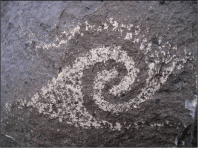 Judging from many ancient petroglyphs found within every corner of the world, it would seem that from very early on, humans have always held an unique relationship with this higher form of consciousness.
Judging from many ancient petroglyphs found within every corner of the world, it would seem that from very early on, humans have always held an unique relationship with this higher form of consciousness.
Perhaps this logos is the very one mentioned in the biblical text of John (1:1):
In the beginning was the Word, and the Word was with God, and the Word was God.Slightly rephrased, we could say:
In the beginning was the Word. And with the Word came sound. And through Sound came form.&rdquo
Or to be more precise:
In the beginning was the Word, and the Word was with DNA and the Word was DNA.
We have the means to affect our future in a positive way. All we need to do is to understand and communicate with the awesome God fractal contained within each of us.
Notes
[1] All Latin translations from the Hieroglyphic Monad used in this article are from Nancy Turner and Terri Burns’ “A Translation of Theorems 1-17 of John Dee’s Monas Hieroglyphica” as published in Journal of the Western Mystery Tradition, Vol. 2, No. 13. (http://www.jwmt.org/v2n13/partial.html)
[2] Petersen, Joseph H., Ed. (2003) John Dee’s Five Books of Mystery. Weiser Books. Boston, MA. p. 270.
[3] Findell, Martin. “The “Book of Enoch”, the Angelic Alphabet and the “Real Cabbala” in the Angelic Conferences of John Dee (1527-1608/9).” The Henry Sweet Society Bulletin, #48, page 15.
[4] Ibid, p. 16.
[5] Hofstadter, Douglas. (1985) Metamagical Themas: Questing for the Essence of Mind and Pattern, Basic Books: NY, p. 174.
[6] Burkle, William S. Arithmetic and Geometric Arguments for the Perfection of the Number of Cards in the Major Arcanum of the Tarot.
[7] Payne-Towler, Christine. (2006). Music and Magic Among the Renaissance Magi. (http://www.tarotarkletters.com/2006/06/world_server.html) Another good resource on the math and ratios of modal construction, 3/7/12 patterning, and the implications of music theory on esoteric alphabets, see Alain Danielou’s Music And The Power Of Sound; The Influence of Tuning and Interval on Consciousness. Inner Traditions: Rochester, VT, 1995.
[8] McClain, Ernest G. (1985) The Myth Of Invariance: the Origin of the Gods, Mathematics and Music from the Rig Veda to Plato, Red Wheel/ Samuel Weiser Publishing. York Beach, ME.
[9] Wang, Robert. (1983). The Qabalistic Tarot. Samuel Weiser Publishing. York Beach, ME. p. 264.
[10] Jenny, Hans (1967).CYMATICS, A Study of Wave Phenomena.
[11] Nakamura, Kimitsugu and Mitsuo Hiramatsu. (2005). “Ultra-weak photon emission from human hand: Influence of temperature and oxygen concentration on emission.” Journal of Photochemistry and Photobiology B: Biology, Volume 80, Issue 2, 1 August 2005, pp 156-160.
[12] Alexjander, Susan. (1999) “The Infrared Frequencies of DNA Bases, as Science and Art.” IEEE Engineering In Medicine and Biology magazine. (www.oursounduniverse.com/articles/IEEE.html)
[13] Burns, T & Moore, JA (2007), “The Hieroglyphic Monad of John Dee Theorems I-XVII: A guide to the Outer Mysteries.” Journal of the Western Mystery Tradition, vol. 2, no. 13. (http://www.jwmt.org/v2n13/sign.html)
[14] Dmitriev, A.N., Dyatlov, V.L., Merculov, V.I. Electrogravidynamic Concept of Tornadoes.
[15] Petersen, op cit.
[16] Alexjander, op cit.
[17] Fosar, Grazyna and Bludorf, Franz (2001) “Vernetzte Intelligenz: Die Natur geht online” Omega-Verlag, Dusseldorf, 2001. (ISBN: 3-930243-23-7) Book is only available in German but excerpts of book have been translated into English on the website http://www.bethcoleman.net/intelligenz.html and the authors’ website is: http://www.fosar-bludorf.com
[18] Alexjander, op cit.
[19] Dossey. L. (1993) “The Body As A Melody: Is Dna Musical?” Magical Blend. March/April. #38. pp. 47-50, 52, 78 (online: http://www.rebprotocol.net/Sep2008 Dossey%20THE%20BODY%20AS%20A%20MELODY-%20IS%20DNA%20MUSICAL%207pp.pdf)